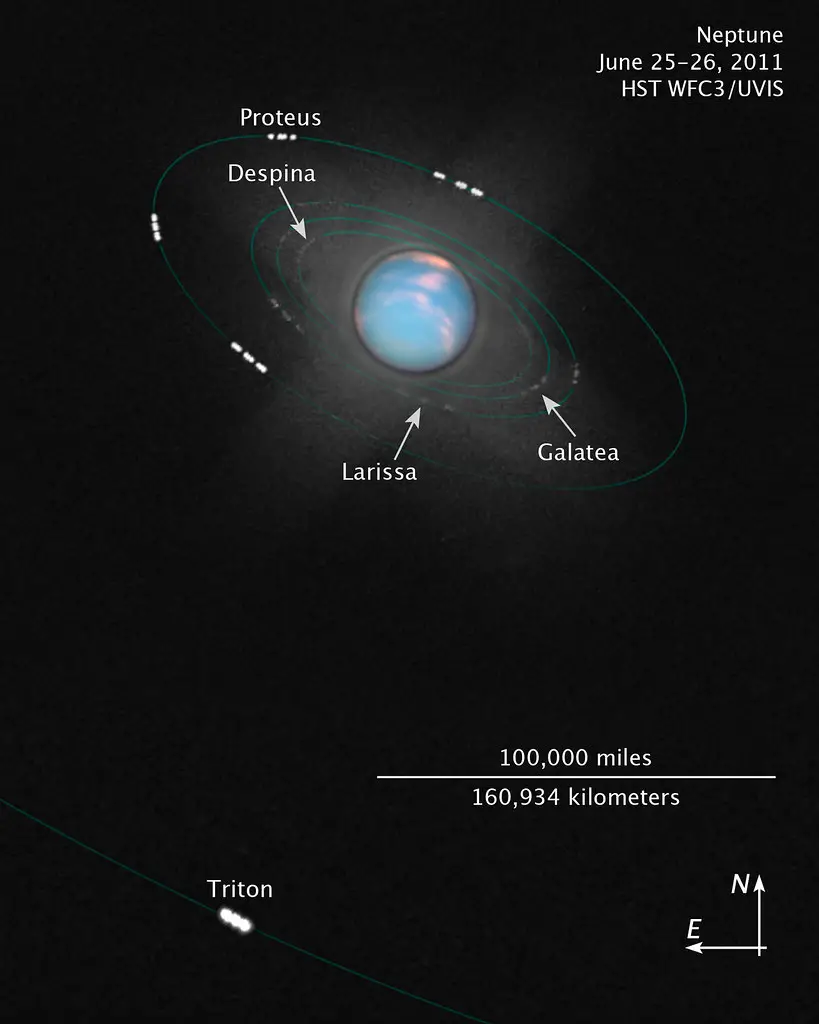Our own moon’s celestial grandeur often captures our wonder as we look up at the wide expanse of the night sky. On the other hand, the intricate structure of our solar system reveals an amazing variety of moons around different planets. Neptune, the eighth and farthest planet from the Sun in our solar system, is a fascinating gas giant among these celestial neighbors. Neptune’s stunning deep blue cover matches its turbulent, constantly changing weather patterns. This mysterious planet, which is well-known for its violent storms and swirling clouds, piques and intrigues our curiosity about the mysteries of the universe.
The Count of Neptune’s Moons
It has been confirmed beyond a shadow of a doubt that Neptune, the eighth and furthest known planet from the Sun in our solar system, has an astounding total of 14 known moons, according to multiple credible sources, including NASA, the renowned space agency known for its groundbreaking discoveries, Caltech, a leading scientific research institution known for its expertise in astronomy, and various esteemed space exploration and astronomy websites that are trusted sources of information in the field. Yes, 14 moons orbit this magnificent gas giant, which is incredible!
These celestial partners of Neptune, each with unique features and enthralling orbits, add to the mysterious charm and attraction of this intriguing planet. Each moon of Neptune has a unique narrative to tell, from Triton, the largest moon, with its ice surface and geysers shooting out nitrogen gas, to Nereid, a small, asymmetrical moon with an extremely eccentric orbit.
In addition to demonstrating the richness and diversity of our planetary neighborhood, the existence of these 14 moons surrounding Neptune poses fascinating queries regarding the genesis and development of planetary systems. Examining and comprehending these moons can help us gain an important understanding of the mechanisms that produced this fascinating gas giant and the dynamics of Neptune’s gravitational interactions.
With its fourteen moons, Neptune stands as a monument to the wonders and limitless possibilities that await us beyond our home planet as we continue to unravel the mysteries of our enormous universe.
The Largest Moon: Triton
Triton is Neptune’s largest and most famous moon. Only 17 days after Neptune was discovered, British astronomer William Lassell made the remarkable discovery of Triton. Being in the opposite direction of Neptune’s rotation, it is the only big moon in the Solar System to have a retrograde orbit. This remarkable characteristic distinguishes Triton from other moons and heightens the intrigue and mystery surrounding this celestial body.
Triton is unique in more ways than just its retrograde orbit. In addition, a remarkable array of geological features, such as cryovolcanoes that shoot frozen plumes into space, can be found there. These cryovolcanoes, which form on Triton’s surface as a result of the eruption of flammable substances like water and nitrogen, produce a dynamic and ever-changing terrain. These cryovolcanoes raise the possibility that Triton has a subterranean ocean, which makes it an even more fascinating place to explore in the future.
Moreover, a network of exquisite and lovely patterns covers Triton’s surface. The tidal forces acting on the frozen crust of the moon are thought to be the cause of these patterns, also referred to as cantaloupe terrain. Triton has an incredibly distinctive and alluring appearance due to the interaction between tidal forces and the moon’s internal structure, which has produced a fascinating mosaic of ridges and troughs.
The mysterious moon Triton holds great potential for teaching us about the dynamics and evolution of moons in our solar system as researchers continue to piece together its mysteries. It is a celestial body ready for amazing discoveries and scientific investigation because of its retrograde orbit, cryovolcanoes, and intriguing surface features.
Other Significant Moons
Nereid is one of Neptune’s other significant moons. This moon, which is the third biggest on Neptune, is well-known for having an extremely erratic orbit. Due to its highly eccentric orbit, Nereid can go up to 9.6 million miles from Neptune and as close as 1.4 million miles from it. Due to the enormous difference in distance, gravitational forces constantly reshape and disturb Nereid’s orbit, producing an captivating cosmic dance.
Neptune has multiple moons that orbit closer to the planet than Nereid. Naiad, Thalassa, Despina, and Galatea are some of these moons. Despina and Galatea are more spherical in shape, whereas Naiad and Thalassa are small, asymmetrical moons. Larger and more noticeable moons with more features are found further away, such as Larissa and Proteus.
Investigating these intriguing moons offers important new perspectives on the dynamics and development of the Neptune system. Through continued investigation and study, scientists are able to learn more about the outer regions of our solar system and continue to solve the mysteries surrounding these celestial objects.
In summary
In conclusion, Neptune’s 14 moons serve as a testament to the complexity and wonder of our universe. Every moon adds to the planet’s overall mystery with its distinct features and orbit, acting as a constant reminder of how big the universe is and how much more has yet to be discovered.
References
![]()
